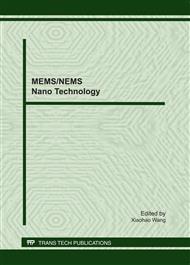[4]
The prototype of the four-electrode conductivity is showed in Fig. 1. It is resembled as a four-terminal precision resistor R. But conductivity is defined as the reciprocal of the resistance (1/R) in ohms, which is measured between two parallel-plate electrodes with a 1mm distance in liquid at a specific temperature. The basic unit of conductance (G) is the Siemens (S) and was formerly called mho. Because a measurement gives the conductance, techniques have been worked out to convert the measured value to the conductivity, so that results can be compared from different experiments.
Google Scholar
[7]
Two electrodes (b1 and b2) are used to force a uniform time varying electric field and the others like (a1 and a2) to measure the voltages. The voltage, excitation-current and conductivity have the relationship is expressed as: U= I / G (3) It is evident from (3) that voltages can be obtained by varying the cell's excitation-current level and the density of water. In this experiment, the excitation-current, I, is fixed as a constant. Then the voltages are only proportional to the conductivities. Fig. 1 Schematic illustrating the parallel-plate arrangement for measuring conductivity It is promising to obtain the conductivity of the analyte by calibrating the voltage to the conductivity of the standard liquid. Simulation and Fabrication The measurement system includes two parts: a four-electrode conductivity sensor unit and an integrated measuring circuit. As well as, the geometry of the conductivity sensing unit is shown in Fig. 1. The conductivity sensor, with a four-electrode (parallel to the discharge axis), was fabricated on the PCB, having a 1 mm thick copper layer. Copper plates (measuring 6mm×2mm or smaller for each), are patterned adjacent to each other with 1mm space. The contacts are made by soldering the wires to the copper plates. The plates are physically and electrically connected with the medium, by coating them with a 0. 5 mm thick solder cost. In order to determine the distance of the viable range of the four-electrode, it's significant to simulate the actual uniform electric field of fabricated sensor. Using MEMS simulation tool, ANSYS, the uniform electric field between charged plates was simulated.
Google Scholar
[8]
Fig . 2. The simulation 0f uniform electric field between with four electrodes Repeated simulated results indicate the practical uniform electric field between with four electrodes is shown in Fig. 2. The distance between the electrode b1 with b2 is 6 mm and the distance between the electrode b1 with a1 is 1 mm. The fabrication of the sensor is done according to the previous simulation of uniform electric field among four electrodes. Experimental results The competed conductivity sensors are tested in a lab environment. The measurement system is shown in Fig. 3, which includes the four-electrode unit, difference amplifier (AD620), Constant Current Source and oscillograph. Fig. 3 The testing system of a four-electrode conductivity sensor The working value of the four-electrode conductivity's excitation- current is set to be 1mA, and the working voltage of difference amplifier is ±15V. At first, it is very significant that the amplification factor of the difference amplifier (AD620) is set to be a constant value. And then, a series of voltages can be obtained by varying the density of water. Meanwhile, the corresponding value of conductivity can be gained by a conductivity sensor (HACH SensION5). The curve of the relationship between voltages with conductivity is obtained as indicating in Fig. 4, when the voltage is 5. 02V and the conductivity represents 200us/cm. In order to acquire the voltage range, the conductivity is changed from 0 us/cm to 1500us/cm at the same condition of the circuit and the same setting. Fig. 4 The tested voltage-conductivity curve while conductivity varies from 0. 4us/cm to 1500us/cm The curve of the relationship between voltages with conductivity was obtained as indicated in figure 4. The conductivity varies from 0. 4us/cm to 1500us/cm while voltage varies from 9. 00V to 0. 34V, which almost covers the possible range of conductivity value in practical fresh water conductivity measurement. Conclusion The proposed prototype is an attractive solution for water quality measurement systems in estuarine zones or rivers. Main characteristics of the proposed prototype include an automatic temperature compensation of conductivity measurements and low sensitivity to disturbances caused by electrolytic polarization, double layer, and fringe effects. According to experimental results, the conductivity varies from 0. 4us/cm to 1500us/cm was easily obtained by detecting the output voltage of the amplifier, and the voltages varies from 9. 00v to 0. 34v could be propitious to data processing which will be done in next job for microprocessor. Acknowledgments The authors would like to thank the International Science and Technology Cooperation and Communication project of the Ministry of Science and Technology of the P.R. China who supported this work.
Google Scholar
[1]
Information on http: /www. lcra. org/water/index. html.
Google Scholar
[2]
N. Brown, New Generation CTD Sensor Systems, IEEE OCEANS, vol. 19 (1987), pp.280-286.
Google Scholar
[3]
Hill, Kenneth D, DYNAMIC RESPONSE OF THE TWO-ELECTRODE CONDUCTIVITY CELL, Oceans (New York), (1987), pp.297-302.
Google Scholar
[4]
H. Ramos, L. Gurriana, O. Postolache, M. Pereira, and P. Girão, Development and characterization of a conductivity cell for water quality monitoring, in Proc. 3rd IEEE Int. Conf. SSD, Sousse, Tunisia, (Mar. 2005).
Google Scholar
[5]
B. Karbeyaz and N. Gençer, Electrical conductivity imaging via contactless measurements: An experimental study, IEEE Trans. Med. Imag., vol. 22, no. 5 (May 2003)., p.627–635.
DOI: 10.1109/tmi.2003.812271
Google Scholar
[6]
A. J. Fougere, New non-external field inductive conductivity sensor (NXIC) for long term deployments in biologically active regions, in Proc. OCEANS MTS/IEEE Conf. Exhib., (Sep. 2000), vol. 1, p.623–630.
DOI: 10.1109/oceans.2000.881324
Google Scholar
[7]
P. Ripka, Advances in fluxgate sensors, Sens. Actuators A, Phys., vol. 106, no. 1–3 (Sep. 2003), p.8–14.
Google Scholar
[8]
A. Hyldgard,D. Mortensen,K. Birkelund,O. Hansen E.V. Thomsen, Autonomous multi-sensor micro-system for measurement of ocean water salinity [J], Sensors and Actuators A, (2008), 147: 474-484.
DOI: 10.1016/j.sna.2008.06.004
Google Scholar


